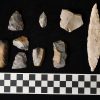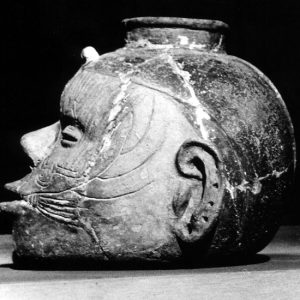calsfoundation@cals.org
Native American Pottery
Indians in Arkansas began making pottery containers about 2,500 years ago, during the Woodland Period, and they continued this craft until their handmade containers were replaced by industrial counterparts made in metal, glass, and clay in the eighteenth and nineteenth centuries. Broken pieces of Indian pottery, called sherds or potsherds, are among the most common artifacts remaining at abandoned settlements, and they provide a wide range of information today about the cultural traditions of the people who made them. Complete pottery vessels display both sophisticated craftsmanship and the complex aesthetics of their makers.
Southeastern Indian pottery-making began in the area of eastern Georgia, South Carolina, and Florida about 4,000 years ago and spread gradually from there to cultures across eastern North America. Potters developed regionally distinctive recipes for making and decorating containers that were followed in many cases for centuries. Both dramatic and subtle differences in pottery shape and decoration also mark local family and village ceramic traditions.
Native pottery was made by hand. Potters dug clay from local deposits and then mixed it with a temper that consisted of small particles of sand, shell, animal bone, pulverized stone, ground potsherds, or some combination of these materials. Temper apparently served to give pottery vessels the ability to withstand the heat from firing and subsequent daily use, although there may be other technological values of some tempers that are as yet unknown.
Containers were shaped by hand in various ways. Some were assembled with clay coils that were compressed and shaped with smoothing stones and other tools. In other cases, clay slabs were apparently assembled along with coils. Handles, feet, and other elements were added as finishing touches. Indians in eastern North America used neither pottery wheels nor molds. As containers dried, they were sometimes scraped with mussel shells or other sharp objects to make thinner walls and smooth surfaces, and decorations were then applied. Rubbing the dry surface with a smooth stone compressed the clay particles and created a light-reflecting polish on the surface. Decorative techniques also included incising and punctuating the still-moist clay; engraving fully dried but unfired vessels; applying a thin clay wash that would fire to a colorful, smooth surface; applying moist spherical or linear clay beads in three-dimensional designs; and painting the surface.
Native potters fired containers in open air, not in kilns. By manipulating the flow of oxygen within the fire, and by removing containers from the fire and plunging them immediately into an oxygen-depleted environment, potters could create certain desired surface colors like oxidized reds and yellows at one end of the spectrum and mahogany browns and blacks at the other.
The variety of vessel shapes and their uses changed through time. Woodland Period containers were simple jar and beaker forms, evidently used mainly for cooking and serving food. Pottery-making may have begun in response to a change in diet. An increase in the use of pounded nut meats and small oily and starchy seeds meant that stews, porridges, and similar foods cooked in containers made pottery both useful and important in daily life. Pottery became important in ritual and social activities as well as in domestic life. Some Woodland Period pottery was elaborately decorated and evidently used in public events at mounds and burial sites. Some special-purpose containers with new shapes, like bottles and platters, also begin to appear during this period.
With the start of the Mississippian Period about 1,000 years ago, pottery-making became more complex. Many new container types appeared, including salt-distilling pans, bowls, saucers, three-legged or “tripod” bottles, and shouldered or “carinated” bowls, as well as a wide array of jar shapes and sizes. Mississippian society was complex, and the pottery-making tradition reflects that complexity. The sophistication of some containers indicates that some individuals and families may have been ceramic specialists who produced very special items only for an elite clientele.
Regional traditions in vessel type and decoration emerge during this period and mark the boundaries between important cultural groups in Arkansas. In southwest Arkansas, Caddo-tradition ceramics are simple container shapes such as jars, bottles, carinated bowls, and “seed” jars. Decoration features complex engraved designs on highly polished “finewares” like bottles and bowls. Cooking jars and other utility wares are heavily decorated with incised, punctuated, and other plastic designs with geometric motifs. This ceramic tradition is also found in adjoining corners of Louisiana, Texas, and Oklahoma, and has been traced down through time to the historic Caddo tribe.
In contrast, Mississippian-tradition pottery from eastern Arkansas features spherical jars, bottles, and other utility wares that were painted, incised or punctuated on portions of the vessel. Fine wares were often molded into animal, plant, or human shapes. Common examples include fish, bird, bat, frog, mussel shell, gourd, human head, and hunchback forms. Some supernatural beings with mixed qualities, like feathered and horned serpents, were engraved on or affixed to containers.
Mississippian pottery was an important element in several social settings. Some pottery was used in daily life to make, store, and serve food. Containers were also used during rituals, as gifts for the deceased, and in political events. Some pottery, like the human head effigy bottles made in eastern Arkansas, commonly called head pots, were probably very special items used only during important events.
Although the brightly painted pottery from eastern Arkansas is commonly called “Quapaw Pottery,” there is not yet evidence linking Mississippian pottery to any specific historic Indian tribe or nation. The expert potters who made the painted, molded, and engraved wares in eastern Arkansas 500 years ago may have been ancestral to the Tunica, the Quapaw, or the Natchez people of the historic era, or to several or none of these groups. The social disruptions that took place in the Mississippi River Valley following the Hernando de Soto expedition of 1541–1543 disrupted and scattered Indian societies and have made it difficult to link the ancestral peoples with any of their likely descendants.
For additional information:
House, John H. Gifts of the Great River: Arkansas Effigy Pottery from the Edwin Curtiss Collection. Cambridge, MA: Peabody Museum Press, Harvard University. 2003.
McKinnon, Duncan P., Jeffrey S. Girard, and Timothy K. Perttula, eds. Ancestral Caddo Ceramic Traditions. Baton Rouge: Louisiana State University Press, 2021.
Suhm, Dee Ann, and Alex D. Krieger. An Introductory Handbook of Texas Archeology. Bulletin of the Texas Archeological Society 25. Davenport, IA: Gustav’s Library, 2008.
Townsend, Richard F., ed. Hero, Hawk, and Open Hand: American Indian Art of the Ancient Midwest and South. Chicago: Art Institute of Chicago, 2004.
Walker, Leslie. “Liminal River: Art, Agency and Cultural Transformation along the Protohistoric Arkansas River.” PhD diss., University of Arkansas, 2014. Online at https://scholarworks.uark.edu/etd/2153/ (accessed July 6, 2022).
Wiewel, Rebecca. “Constructing Community in the Central Arkansas River Valley: Ceramic Compositional Analysis and Collaborative Archaeology.” PhD diss., University of Arkansas, 2014. Online at https://scholarworks.uark.edu/etd/2077/ (accessed July 6, 2022).
Ann M. Early
Arkansas Archeological Survey
 Carden Bottom
Carden Bottom Head Pot
Head Pot 




Comments
No comments on this entry yet.